
Left to right. Doug Lawler with Continental Resources, Malone Mitchell III of TransAtlantic Petroleum and Longfellow Energy, and Jeff Gustavson with Chevron Cop. were among speakers at the Powering AI summit at the Hamm Institute for American Energy April 24 in Oklahoma City. (Source: Hamm Institute for American Energy)
OKLAHOMA CITY—The tangled regulatory web in New Mexico is “a nightmare,” a Dallas-based international E&P’s chief said.
“I’ve been in this business a long time, and I’ve never seen anything like it,” Malone Mitchell III, chairman and CEO of TransAtlantic Petroleum, said at the recent Hamm Institute for American Energy summit on developing infrastructure to power AI.
Mitchell, who formed his first E&P in 1985, is also president of Longfellow Energy, which operates in the Permian Basin, Midcontinent and northern and eastern Texas.
Connecting operations to electricity is one impasse, Mitchell said.
“It’s so controlled as to the ability to even generate your own power and use the lines that we’ve prepaid and [use the] right of ways,” Mitchell said.
“The arcane nature of the prior administrations giving you a permit but then denying you the ability to develop your permits through the regulatory control there.”
Meanwhile, TransAtlantic is exploring in Turkey. “Turkey’s great, regulatory-wise,” he said.
Oklahoma City-based Continental Resources recently signed a deal to join Mitchell in wildcatting tight-rock oil and gas resources in Turkey’s Diyarbakir Basin.
“We felt like it was much better to utilize our resources with a much larger, more financially capable partner,” Mitchell said.
Continental President and CEO Doug Lawler, who joined Mitchell on the panel, said, “When we were discussing with [Mitchell] this opportunity in Turkey and someone with [his] experience says, from a regulatory environment [and] operating environment, it’s easier to operate in a foreign location than it is in the United States or in certain areas of the United States, that’s an important statement.”
Mitchell’s remark about operating in New Mexico is similar to recently retired Devon Energy chief Rick Muncrief’s comments at a joint Dallas Fed and Kansas City Fed energy conference in November.
Devon operates on federal land in southeastern New Mexico in the Delaware Basin.
The area is running out of electricity, Muncrief said.
And “you have a utility company that is shrugging their shoulders, pointing their finger at the BLM [federal Bureau of Land Management] because they can’t get a permit” to place the power infrastructure.
The utility is also pointing at the regional transmission operator (RTO), the Southwest Power Pool, for example, and “Southwest Power Pool is saying, ‘It’s not us,’” Muncrief told the Fed.
‘Tremendous obstacle’
“The U.S. has a lot of political risk,” said Jeff Gustavson, vice president, lower carbon energies, for Chevron Corp., at the summit. “And when you get to the state level, we’re very sensitive to that, as well.”
Chevron operates in 27 countries, including Kazakhstan, West Africa and Venezuela. “All of these areas have political challenges, certainly,” Gustavson said.
In the U.S., its E&P business is primarily focused on the Permian Basin, Colorado and deepwater Gulf of Mexico offshore Louisiana.
“They’re not just large capital investments; they’re capital [projects] … that will extend decades into the future,” he said.
Maynard Holt, co-founder and CEO of capital research and advisory firm Veriten, asked the panel what the industry needs to tell politicians.
Mitchell said, “The regulatory ability to move [seamlessly] from state lands to BLM lands to private lands. The BLM … is a tremendous obstacle.
“And then you layer on top of that the individual utility restrictions. Water, power and gas takeaways are dramatic challenges [in New Mexico].”
It can be solved, “but they have to be solved from the top down. It’s very difficult to solve them from the bottom up.”
Lawler said Continental will run out of permits this year for drilling on federal land in Wyoming’s Powder River Basin.
“It’s really critical that you get something in place that allows for permitting … to be sped up—but also permanently” and not from administration to administration so “then we can’t have confidence,” Lawler said.
Recommended Reading
FERC Approves Enstor’s Salt-Dome Storage Expansion in Mississippi
2025-04-15 - The Mississippi Hub’s total natural gas capacity will reach approximately 56.3 Bcf, Enstor Gas said.
DOE Awards BWX Technologies $2.6B Contract to Operate SPR
2025-04-09 - BWX Technologies has formed Strategic Storage Partners LLC with APTIM Federal Services to operate and maintain quality control at U.S. Strategic Petroleum Reserve sites.
US NatGas in Storage Grows for Second Week
2025-03-27 - The extra warm spring weather has allowed stocks to rise, but analysts expect high demand in the summer to keep pressure on U.S. storage levels.
LNG Leads the Way of ‘Energy Pragmatism’ as Gas Demand Rises
2025-03-20 - Coastal natural gas storage is likely to become a high-valued asset, said analyst Amol Wayangankar at Hart Energy’s DUG Gas Conference.
Energy Transfer’s Lake Charles LNG to Supply Kyushu for 20 Years
2025-05-29 - Energy Transfer has agreed to supply Kyushu Electric Power Co. with up to 1 million tonnes per annum of LNG from its Lake Charles facility.
Comments
Add new comment
This conversation is moderated according to Hart Energy community rules. Please read the rules before joining the discussion. If you’re experiencing any technical problems, please contact our customer care team.






